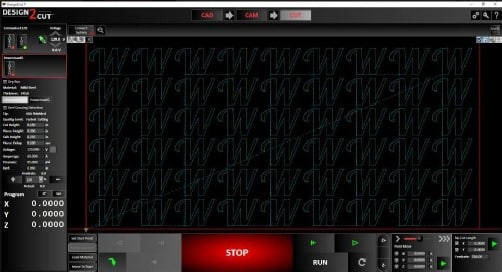This is a topic that comes up on a pretty regular basis in the groups and forums. How much do I charge for a piece? How do I do estimates? Very common questions, and there are a million options but I’m going, to share what I recommend my customer do. It’s super simple and easy, it works for quick estimates, and jobs big or small.
Before you can charge for something, you need to know how much it costs. Open an excel spreadsheet, or just make a simple table like the one below.
With the table below, you can quickly determine your cost on a full sheet and break it down to a price per square inch. It has the added benefit of telling you weight. So you can determine how much a piece will weigh, both for shipping and customer inquiry. All this information can be obtained from your steel supplier. You can build on this sheet each time you get a request for a new material, and pretty soon you will have a portfolio of materials you can choose from and compare for the customer. I have about 60 sheet materials that I track. Steel prices vary, they are always changing, and your prices should be rounded up just a bit to account for that. Be sure to check your prices from time to time to make sure you’re still in the ball park.
| Material | Weight 4×8 | Weight SQIN | Cost 4×8 | Cost SQIN | Cost x3 | Cost x4 | Cost x5 | Cost x6 |
| 20g Cold Roll | 48 | 0.0104 | $35.00 | $0.008 | $0.024 | $0.032 | $0.040 | $0.048 |
| 18g Cold Roll | 64 | 0.0139 | $45.00 | $0.010 | $0.030 | $0.040 | $0.050 | $0.060 |
| 16g Cold Roll | 80 | 0.0174 | $55.00 | $0.012 | $0.036 | $0.048 | $0.060 | $0.072 |
| 14g Cold Roll | 100 | 0.0217 | $65.00 | $0.014 | $0.042 | $0.056 | $0.070 | $0.084 |
| 10g Cold Roll | 180 | 0.0391 | $115.00 | $0.025 | $0.075 | $0.100 | $0.125 | $0.150 |
So how does this work for estimates and quoting? Why the Cost x3, x4, x5, x6? We can see from this table how much the material will cost, down to the sqin. So when a customer calls up and says, “I want a sign made”, you ask, “What do you want it made out of? Steel, Aluminum, Stainless? How Thick / What Gauge? And How big do you want it to be?” With these three simple questions, you can determine your cost in seconds.
Knowing what column you’re in for charging the customer x3, x4, x5, x6 Will take a few jobs and a little experience to determine. When I first started out, and I was learning and practicing so I operated in the x3 column. I knew this covered the material and If I made a mistake I could make another without losing money. Then I would likely cover my expenses if I did not mess up. This is a good place to start. You will have low prices, you can get people in the door, learn your craft, and gain experience. While you gain experience, you need to be tracking time and expenses. You can do this with quickbooks accounting software.
When you use this chart, it’s main purpose is telling you what your material cost is. The x3, x4, x5, x6 is where you can figure in add-ons, like painting or powder coating. You can label the x columns with paint or powder, bare steel etc. With a little tracking in the beginning, you can come up with a very accurate way to quote pieces. I have seen many people try and quote based on time it takes to cut and number of pierces etc. But all of these rely on doing all the artwork prior to being able to quote. If the customer decides not to use you, then you just wasted a bunch of time.
Find a margin that allows you to make money and pay for expenses. Find your shop hourly rate. This is covering labor, consumables, electricity, business expenses etc. Most mechanic shops are $80 to $120 an hour. Every area of the country is different. Competition in your area will also be a factor. I have found that this is a great and easy way to quote.
Artwork / CAD Time – For doing artwork design, and CAD time, Desert Fabworks charges $60 per hour and bills in 15 min increments. This is a very fare wage for CAD time. If there is a design or something simple they can do in 15 min or less, they usually do it for free just as a way to keep customers happy. They will also do some items for free, if it’s a design or object that they can use and resell. If they charge a customer for artwork or CAD time for a piece, ethically they believe that the design belongs to the customer. Just something to consider.
Summary – So that is my take on estimating projects and pricing things out. With a little time tracking and determining your cost in materials / consumables, you can create a very accurate picture of your operating costs. Then factor this into a pricing column per sqin of material cut, and you get a very fast and accurate way to price. Taking only seconds to do so, you’re not wasting time or money. You can also create custom columns for secondary operations, like paint or powder coating. With also tracking weight, you can determine what wall anchors you might need. You can also do a pretty accurate estimate of shipping cost before you have even cut one piece. Using this system also makes your pricing very consistent and accurate. When you’re just throwing random prices out there and you have a repeat customer, you’re not going to look professional. With this strategy you are accurate and consistent from one job to the next.



